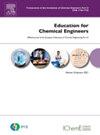流化床教室的实际操作和评估
IF 2.3
2区 教育学
Q1 EDUCATION, SCIENTIFIC DISCIPLINES
引用次数: 0
摘要
在这项研究中,我们考察了首次在化学工程课堂上使用微型流化床模块的情况。我们开发的学习活动旨在促进布卢姆分类法高层次的学习,并在 ICAP 框架内提供互动、建设性和积极的参与,以促进对概念的深入理解。在一堂 50 分钟的课上,通过桌面级流化床和强化印刷工作表材料开展了一项实践活动,以鼓励学生参与。模块性能测试结果与基于理论模型的预测结果相比较,表明该工具可以有效地演示与填料床中的压力损失、最小流化速度、流化床中的恒定压降、床的膨胀以及顶部滤网下方的重新填料有关的基本概念。前测和后测 1 和 2 显示,与单纯的讲座相比,学生在完成课前作业和实践活动后的学习效果明显提高。通过学生对前、后测试 1 和 2 中两个开放式问题的回答,我们发现了学生对填料床和流化床一直存在的误解。Tweetable 摘要 在化学工程课堂上使用流化床实践学习工具实现填料床和流化床的可视化,以及对概念学习和学生参与的相关影响。本文章由计算机程序翻译,如有差异,请以英文原文为准。
Hands-on fluidized bed classroom implementation and assessment
In this study we examined the first-time use of a miniaturized fluidized bed module in a chemical engineering classroom. Learning activities were developed to foster learning at the higher levels of Bloom's taxonomy and within the ICAP framework to provide interactive, constructive, and active engagement to promote a deeper understanding of concepts. A hands-on activity facilitated by a desktop-scale fluidized bed and reinforcing printed worksheet materials was deployed within a 50-min class to encourage student engagement. Results from module performance tests compare well to predictions based on theoretical models suggesting this tool can effectively demonstrate fundamental concepts related to pressure loss in a packed bed, minimum fluidization velocity, constant pressure drop in a fluidized bed, bed expansion and repacking below a top screen. Pre- and Posttests 1 and 2 show student learning was significantly improved after pre-homework and the hands-on activity compared to the learning after the lecture alone. Student responses to two open-ended questions on Pre- and Posttests 1 and 2 allowed us to identify persisting student misconceptions about packed and fluidized beds. Suggestions for future work to repair these misconceptions are included in this study.
Tweetable Abstract
A hands-on fluidized bed learning tool enabling visualization of packed and fluidized beds in a chemical engineering classroom, and associated impacts on conceptual learning and student engagement.
求助全文
通过发布文献求助,成功后即可免费获取论文全文。
去求助
来源期刊

Education for Chemical Engineers
Multiple-
CiteScore
8.80
自引率
17.90%
发文量
30
审稿时长
31 days
期刊介绍:
Education for Chemical Engineers was launched in 2006 with a remit to publisheducation research papers, resource reviews and teaching and learning notes. ECE is targeted at chemical engineering academics and educators, discussing the ongoingchanges and development in chemical engineering education. This international title publishes papers from around the world, creating a global network of chemical engineering academics. Papers demonstrating how educational research results can be applied to chemical engineering education are particularly welcome, as are the accounts of research work that brings new perspectives to established principles, highlighting unsolved problems or indicating direction for future research relevant to chemical engineering education. Core topic areas: -Assessment- Accreditation- Curriculum development and transformation- Design- Diversity- Distance education-- E-learning Entrepreneurship programs- Industry-academic linkages- Benchmarking- Lifelong learning- Multidisciplinary programs- Outreach from kindergarten to high school programs- Student recruitment and retention and transition programs- New technology- Problem-based learning- Social responsibility and professionalism- Teamwork- Web-based learning
 求助内容:
求助内容: 应助结果提醒方式:
应助结果提醒方式:


